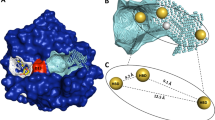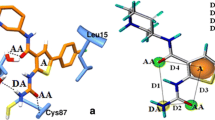Abstract
The kinase-regulatory cell signaling networks play a central role in the pathogenesis of human cervical cancer (hCC). However, only few kinase inhibitors have been successfully developed for treatment of this cancer to date. Considering that the active sites of protein kinases are highly conserved and small-molecule inhibitors should generally exhibit high promiscuity and broad specificity across the hCC-related kinase array, it is supposed that the established kinase targets of hCC can be targeted unexpectedly by certain noncognate kinase inhibitors. This provides a novel idea to practice the new uses for old drugs in anti-cancer chemotherapy. Here, we create a systematic kinase–inhibitor binding profile in a high-throughput manner by molecular docking and consensus scoring, where the kinases have been collected as therapeutic targets of hCC and the inhibitors are reversible, ATP-competitive and readily available. The docking/scoring scheme is tested rigorously with structure-solved and affinity-known kinase–inhibitor complex samples, which is later demonstrated to be effective in inferring unexpected inhibitor response to hCC-related kinases. Few promising kinase–inhibitor pairs are identified from the profile and tested experimentally at cellular and molecular levels. It is found that the kinase–inhibitor promiscuity is a common phenomenon but only few can interaction effectively and inhibit potently. In addition, the high-scoring inhibitors generally exhibit good suppressing potency on hCC cell viability as compared to those low-scoring ones, imparting that the created profile can well reflect the tumor cytotoxicity of noncognate kinase inhibitors. A further kinase assay suggests that the ErbB family kinases are the potential targets of these high-scoring inhibitors, with noncognate inhibitory activity up to nanomolar level. Structure analysis reveals that the nonbonded interactions of potent noncogante kinase–inhibitor binding can divided into a polar tail and a nonpolar lobe, which confer specificity and stability to the binding, respectively.





Similar content being viewed by others
References
Shchemelinin I, Sefc L, Necas E (2006) Protein kinases, their function and implication in cancer and other diseases. Folia Biol 52:81–100
Manning G, Whyte DB, Martinez R, Hunter T, Sudarsanam S (2002) The protein kinase complement of the human genome. Science 298:1912–1934
Roskoski R (2015) A historical overview of protein kinases and their targeted small molecule inhibitors. Pharmacol Res 100:1–23
Bhullar KS, Lagarón NO, McGowan EM, Parmar I, Jha A, Hubbard BP, Rupasinghe HPV (2018) Kinase-targeted cancer therapies: progress, challenges and future directions. Mol Cancer 17:48
Vu M, Yu J, Awolude OA, Chuang L (2018) Cervical cancer worldwide. Curr Probl Cancer 42:457–465
Liu S, Hao X, Ouyang X, Dong X, Yang Y, Yu T, Hu J, Hu L (2016) Tyrosine kinase LYN is an oncotarget in human cervical cancer: a quantitative proteomic based study. Oncotarget 7:75468–75481
Qiu H, Li J, Liu Q, Tang M, Wang Y (2018) Apatinib, a novel tyrosine kinase inhibitor, suppresses tumor growth in cervical cancer and synergizes with Paclitaxel. Cell Cycle 17:1235–1244
Lee CM, Fuhrman CB, Planelles V, Peltier MR, Gaffney DK, Soisson AP, Dodson MK, Tolley HD, Green CL, Zempolich KA (2006) Phosphatidylinositol 3-kinase inhibition by LY294002 radiosensitizes human cervical cancer cell lines. Clin Cancer Res 12:250–256
Taylor SS, Radzio-Andzelm E (1994) Three protein kinase structures define a common motif. Structure 2:345–355
Chong CR, Sullivan DJ (2007) New uses for old drugs. Nature 448:645–646
Zhu Q, Chen J, Wu X, Jin X, Ruan B (2014) Repurposing of kinase inhibitors to target c-Abl as potential therapeutics for Alzheimer’s disease. J Pharm Innov 9:331–340
Zhu LX, Liu Q, Hua YF, Yang N, Zhang XG, Ding X (2019) Systematic profiling and evaluation of structure-based kinase-inhibitor interactome in cervical cancer by integrating in silico analyses and in vitro assays at molecular and cellular levels. Comput Biol Chem 80:324–332
Zhao L, Huang Q, Tian S, Ge J, Zhu H, Dong Q (2019) Integrative identification of unexpected kinase-inhibitor interactions in the MAPK-mediated proliferation and differentiation of Mc3T3-E1 osteoblasts. Gen Physiol Biophys 38:1–13
Grueneberg DA, Li W, Davies JE, Sawyer J, Pearlberg J, Harlow E (2018) Kinase requirements in human cells: IV. Differential kinase requirements in cervical and renal human tumor cell lines. Proc Natl Acad Sci USA 105:16490–16495
Ashburner M, Ball CA, Blake JA, Botstein D, Butler H, Cherry JM, Davis AP, Dolinski K, Dwight SS, Eppig JT, Harris MA, Hill DP, Issel-Tarver L, Kasarskis A, Lewis S, Matese JC, Richardson JE, Ringwald M, Rubin GM, Sherlock G (2000) Gene ontology: tool for the unification of biology. Nat Genet 25:25–29
Berman HM, Westbrook J, Feng Z, Gilliland G, Bhat TN, Weissig H, Shindyalov IN, Bourne PE (2000) The protein data bank. Nucleic Acids Res 28:235–242
Tian F, Zhou P, Kang W, Luo L, Fan X, Yan J, Liang H (2015) The small-molecule inhibitor selectivity between IKKα and IKKβ kinases in NF-κB signaling pathway. J Recept Signal Transduct Res 35:307–318
Chen HF, Pan XL, Wang JW, Kong HM, Fu YM (2014) Protein-drug interactome analysis of SSRI-mediated neurorecovery following stroke. Biosystems 120:1–9
Liu L, Chen X, Liu W, Yu H, Liu F (2019) Statistical analysis and heuristic identification of unexpected interactions from the neurokinase–inhibitor interactome in trigeminal neuralgia pharmacological intervention. J Chemom 33:e3126
Morris GM, Goodsell DS, Halliday RS, Huey R, Hart WE, Belew RK, Olson AJ (1998) Automated docking using a Lamarckian genetic algorithm and an empirical binding free energy function. J Comput Chem 19:1639–1662
Word JM, Lovell SC, Richardson JS, Richardson DC (1999) Asparagine and glutamine: using hydrogen atom contacts in the choice of side-chain amide orientation. J Mol Biol 285:1735–1747
Ryu J, Lee M, Cha J, Laskowski RA, Ryu SE, Kim DS (2016) BetaSCPWeb: side-chain prediction for protein structures using Voronoi diagrams and geometry prioritization. Nucleic Acids Res 44:W416–W423
Morris GM, Huey R, Lindstrom W, Sanner MF, Belew RK, Goodsell DS, Olson AJ (2009) AutoDock4 and AutoDockTools4: automated docking with selective receptor flexibility. J Comput Chem 30:2785–2791
Luo H, Du T, Zhou P, Yang L, Mei H, Ng H, Zhang W, Shu M, Tong W, Shi L, Mendrick DL, Hong H (2015) Molecular docking to identify associations between drugs and class I human leukocyte antigens for predicting idiosyncratic drug reactions. Comb Chem High Throughput Screen 18:296–304
Yang C, Wang C, Zhang S, Huang J, Zhou P (2015) Structural and energetic insights into the intermolecular interaction among human leukocyte antigens, clinical hypersensitive drugs and antigenic peptides. Mol Simul 41:741–751
Yang C, Zhang S, He P, Wang C, Huang J, Zhou P (2015) Self-binding peptides: folding or binding. J Chem Inf Model 55:329–342
Yang C, Zhang S, Bai Z, Hou S, Wu D, Huang J, Zhou P (2016) A two-step binding mechanism for the self-binding peptide recognition of target domains. Mol BioSyst 12:1201–1213
Forli S, Huey R, Pique ME, Sanner MF, Goodsell DS, Olson AJ (2016) Computational protein-ligand docking and virtual drug screening with the AutoDock suite. Nat Protoc 11:905–919
Yang JM, Chen YF, Shen TW, Kristal BS, Hsu DF (2005) Consensus scoring criteria for improving enrichment in virtual screening. J Chem Inf Model 45:1134–1146
Wang R, Lu Y, Wang S (2003) Comparative evaluation of 11 scoring functions for molecular docking. J Med Chem 46:2287–2303
Cong L, Xia ZK, Yang RY (2014) Targeting the TGF-β receptor with kinase inhibitors for scleroderma therapy. Arch Pharm 347:609–615
Huang L, Huang QY, Huang HQ (2014) The evidence of HeLa cell apoptosis induced with tetraethylammonium using proteomics and various analytical methods. J Biol Chem 289:2217–2229
Sun QM, Miao ZH, Lin LP, Gui M, Zhu CH, Xie H, Duan WH, Ding J (2009) BB, a new EGFR inhibitor, exhibits prominent anti-angiogenesis and antitumor activities. Cancer Biol Ther 8:1640–1647
Zhou P, Yang C, Ren Y, Wang C, Tian F (2013) What are the ideal properties for functional food peptides with antihypertensive effect? A computational peptidology approach. Food Chem 141:2967–2973
Zhou P, Wang C, Tian F, Ren Y, Yang C, Huang J (2013) Biomacromolecular quantitative structure-activity relationship (BioQSAR): a proof-of-concept study on the modeling, prediction and interpretation of protein-protein binding affinity. J Comput Aided Mol Des 27:67–78
Gaieb Z, Liu S, Gathiaka S, Chiu M, Yang H, Shao C, Feher VA, Walters WP, Kuhn B, Rudolph MG, Burley SK, Gilson MK, Amaro RE (2018) D3R Grand Challenge 2: blind prediction of protein-ligand poses, affinity rankings, and relative binding free energies. J Comput Aided Mol Des 32:1–20
Wang B, Shen W, Yang H, Shen J, Sun T (2014) Targeting EGFR mutants with non-cognate kinase inhibitors in non-small cell lung cancer. Med Chem Res 23:4510–4530
Cui YH, Chen J, Xu T, Tian HL (2015) Structure-based grafting and identification of kinase-inhibitors to target mTOR signaling pathway as potential therapeutics for glioblastoma. Comput Biol Chem 54:57–65
Wang R, Fang X, Lu Y, Wang S (2004) The PDBbind database: collection of binding affinities for protein-ligand complexes with known three-dimensional structures. J Med Chem 47:2977–2980
Hill AD, Reilly PJ (2015) Scoring functions for AutoDock. Methods Mol Biol 1273:467–474
Bai Z, Hou S, Zhang S, Li Z, Zhou P (2017) Targeting self-binding peptides as a novel strategy to regulate protein activity and function: a case study on the proto-oncogene tyrosine protein kinase c-Src. J Chem Inf Model 57:835–845
Zhou P, Hou S, Bai Z, Li Z, Wang H, Chen Z, Meng Y (2018) Disrupting the intramolecular interaction between proto-oncogene c-Src SH3 domain and its self-binding peptide PPII with rationally designed peptide ligands. Artif Cells Nanomed Biotechnol 46:1122–1131
Li Z, Yan F, Miao Q, Meng Y, Wen L, Jiang Q, Zhou P (2019) Self-binding peptides: binding-upon-folding versus folding-upon-binding. J Theor Biol 469:25–34
Meng L, Huang Z (2018) In silico-in vitro discovery of untargeted kinase-inhibitor interactions from kinase-targeted therapies: a case study on the cancer MAPK signaling pathway. Comput Biol Chem 75:196–204
Baell J, Walters MA (2014) Chemistry: chemical con artists foil drug discovery. Nature 513:481–483
Soonthornthum T, Arias-Pulido H, Joste N, Lomo L, Muller C, Rutledge T, Verschraegen C (2011) Epidermal growth factor receptor as a biomarker for cervical cancer. Ann Oncol 22:2166–2178
Sequist LV, Besse B, Lynch TJ, Miller VA, Wong KK, Gitlitz B, Eaton K, Zacharchuk C, Freyman A, Powell C, Ananthakrishnan R, Quinn S, Soria JC (2010) Neratinib, an irreversible pan-ErbB receptor tyrosine kinase inhibitor: results of a phase II trial in patients with advanced non-small-cell lung cancer. J Clin Oncol 28:3076–3083
Ono M, Hirata A, Kometani T, Miyagawa M, Ueda S, Kinoshita H, Fujii T, Kuwano M (2004) Sensitivity to gefitinib (Iressa, ZD1839) in non-small cell lung cancer cell lines correlates with dependence on the epidermal growth factor (EGF) receptor/extracellular signal-regulated kinase 1/2 and EGF receptor/Akt pathway for proliferation. Mol Cancer Ther 3:465–472
Zhou P, Zhang S, Wang Y, Yang C, Huang J (2016) Structural modeling of HLA-B*1502 peptide carbamazepine T-cell receptor complex architecture: implication for the molecular mechanism of carbamazepine-induced Stevens-Johnson syndrome toxic epidermal necrolysis. J Biomol Struct Dyn 34:1806–1817
Li Z, Miao Q, Yan F, Meng Y, Zhou P (2019) Machine learning in quantitative protein-peptide affinity prediction: implications for therapeutic peptide design. Curr Drug Metab 20:170–176
Zhou P, Miao Q, Yan F, Li Z, Jiang Q, Wen L, Meng Y (2019) Is protein context responsible for peptide-mediated interactions? Mol Omics. https://doi.org/10.1039/c9mo00041k
Yu H, Zhou P, Deng M, Shang Z (2014) Indirect readout in protein–peptide recognition: a different story from classical biomolecular recognition. J Chem Inf Model 54:2022–2032
Jubb HC, Higueruelo AP, Ochoa-Montaño B, Pitt WR, Ascher DB, Blundell TL (2017) Arpeggio: a web server for calculating and visualizing interatomic interactions in protein structures. J Mol Biol 429:365–371
Acknowledgements
This work was supported by the JFPH Foundation.
Author information
Authors and Affiliations
Corresponding author
Ethics declarations
Conflict of interest
The authors declare that they have no conflict of interest.
Additional information
Publisher's Note
Springer Nature remains neutral with regard to jurisdictional claims in published maps and institutional affiliations.
Electronic supplementary material
Below is the link to the electronic supplementary material.
Rights and permissions
About this article
Cite this article
Han, M., Sun, D. Rational creation and systematic analysis of cervical cancer kinase–inhibitor binding profile. J Comput Aided Mol Des 33, 689–698 (2019). https://doi.org/10.1007/s10822-019-00211-1
Received:
Accepted:
Published:
Issue Date:
DOI: https://doi.org/10.1007/s10822-019-00211-1




